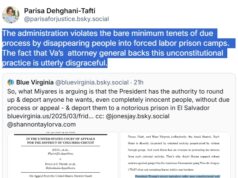From the Commonwealth Institute for Fiscal Analysis:
Black Teens Are Far More Likely to be Trapped in Virginia’s Outdated Youth Prison System; Policymakers Should Choose Alternatives That Work Better
Proven alternatives in other states reduce recidivism and make for safer communities
RICHMOND, VA — Twenty-one percent of Virginia teens age 15 to 17 are Black, yet 72% of young people sent to the custody of Virginia’s Department of Juvenile Justice are Black, according to a new report jointly released by The Commonwealth Institute for Fiscal Analysis and Reinvest In Supportive Environments (RISE) for Youth. The report also lays out how the high rate of young people being sent to the custody of Virginia’s youth prison system is not just by chance: Virginia’s historic and ongoing racial discrimination in housing and employment opportunities means many young Black Virginians grow up in neighborhoods and communities that struggle to provide the resources that every young person needs to thrive. With high exposure to trauma and insufficient funding for school-based supports such as school counselors, plus racial bias that leads to Black youth being seen as more threatening than White youth, too many young Black Virginians end up getting pushed out of school and into contact with law enforcement.
(Note: Del. Jeion A. Ward and RISE for Youth will be formally announcing the Healthy Communities Secure Care legislation tonight, Nov. 12, at 6pm in Hampton, VA. This report affirms the purposes of that legislation.)
“Virginia can and should invest in uplifting communities and dismantling barriers facing Black families,” stated report co-author Valerie Slater, Esq, the executive director of RISE for Youth. “Investing in positive organizations and service providers that are genuinely grounded in low-income Black communities would provide immediate relief for families struggling to survive in communities that are still carrying the legacy of red-lining, displacement through urban renewal schemes, and a two-tier discriminatory job market.”
The 10 cities and counties in Virginia that send the most young people to the custody of the Department of Juvenile Justice also have child poverty rates above the state average and a higher-than-average share of teenagers who are Black.
“Helping families with low incomes overcome barriers to bring home enough money to support their families is an important part of addressing the high rate of incarceration of young people of color – but it’s not enough. There is a stronger correlation in Virginia between the share of young people who are Black and a city or county’s rate of young people being committed to the custody of DJJ than there is between the poverty rate and commitment rates,” stated report co-author Gary Broderick, the Legislative Coordinator of RISE for Youth.
Newly proposed “Healthy Communities Secure Care” legislation supported by RISE for Youth and The Commonwealth Institute would end Virginia’s use of failed large prisons and require that, for the small number of young people who cannot remain in their homes, the state would use smaller facilities with a maximum of 30 young people close to a young person’s family. Smaller facilities help ensure an environment where youth know their peers and administrators. Research in the field of juvenile justice shows that the reduction in anonymity and associated isolation reduces the likelihood of violence and increases the chance for trust building among peers and between peers and administrators. This trust is critical to ensuring a rehabilitative process that promotes the mental health of the youth and public safety.
“When young people are housed in their communities, they are able to maintain important social relationships, remain engaged with their school work, and interact with staff they understand to be part of their community — all of which reduce recidivism,” stated report co-author Laura Goren, the Research Director of The Commonwealth Institute.
The Commonwealth Institute found in a prior report that the use of large youth prisons in Virginia is counterproductive to getting young people back on the right track. As of that analysis, almost three-quarters of youth who have been held in Virginia’s juvenile prisons are convicted of another crime within three years of release. By failing to help young Virginians become productive adults, Virginia’s youth prison system is also failing to keep communities safe.
Several other states have implemented juvenile justice reforms, reducing the use of ineffective, outdated youth prisons, without seeing any increase in crime. Since 1995, California has reduced its rate of youth confinement by 94%. At the same time, the juvenile crime rate fell 67% and the felony crime rate fell 71%. Ohio and Texas both slashed their rate of confinement in state facilities by 75% between 1997 and 2013 while also seeing decreases in their crime rate.
The full report, Ending the Cycle of Incarceration for Black Youth, is available at www.thecommonwealthinstitute.org.
About The Commonwealth Institute
The Commonwealth Institute for Fiscal Analysis provides credible, independent, and accessible information and analyses of fiscal and economic issues with particular attention to the impacts on low- and moderate-income persons. Our products inform fiscal and budget policy debates and contribute to sound decisions that improve the well-being of individuals, communities and Virginia as a whole. Visit www.thecommonwealthinstitute.org for more information.



 Sign up for the Blue Virginia weekly newsletter
Sign up for the Blue Virginia weekly newsletter






![Video: UVA Prof. Larry Sabato Says We “Need to Take [Trump] Seriously” Regarding His Threat to Seek a Third Term](https://bluevirginia.us/wp-content/uploads/2025/03/sabatocnn1-100x75.jpg)

